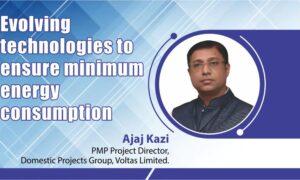Together, all of us can and need to change our environment; only then our future is safe.
We know that as a human being, we could consume around a kg. of food per day, around two and a half litres of water, but up to 12,000 to 15,000 litres of air. But unfortunately, most of the times, we do not take anybody very seriously, despite the fact that we spend 80 percent to 90 percent plus of our time indoors and not outdoors, and whatever you might do however tight the mounting might be: 25 percent of outdoor pollutants can still get into an indoor space. So, we need to be very, very conscious about the inbuilt environment, the spaces we are living in whether it’s our home, whether it’s our office, or restaurant, visiting, or a mall or a shop, wherever you’re going, we need to be very conscious of the indoor environment.
Indoor environment and distribution of air
So, I like to start with what does an indoor environment basically means, we normally just talked about indoor air quality. But when we look at indoor environment as a whole, it actually encompasses four aspects. Number one is thermal comfort; it talks around the range of temperature, etc. And also, humidity, which is also very prominent, we normally use an air conditioner, saying that as long as I’m feeling at 23 degrees, I’m feeling cold, I’m actually very good from an indoor environment point of view. But no! The second most important thing is the indoor air quality as the kind of air, you’re breathing with all the contaminants, etc. The other two aspects which affect indoors are the lighting and acoustics, all these elements are very well covered in IAQ standard, which was launched by ISHRAE and again was renewed in 2019, you can go to the website and download this book to know more about the standard on indoor environment.
Now if you need to improve the indoor air quality, we as engineers, as HVAC design engineers, talk about various ways of doing. It obviously starts with a good design, whether it’s the integrated building design, that means to position the orientation, the intake exhaust points to how do we ensure that the building is designed in a variable manner. Then we talk about ventilation as the most important parameters to be able to ensure a good air quality, followed by air cleaning filtration.
Distribution of air is necessary as we need to ensure that the right air is reaching at every point and not just being left somewhere to have flow on its own. We talk of pressurisation, whether it’s internal external, we want to manage the moisture content inside. But that’s a very, very, big enemy of the indoor environment conditions source control. That means the kind of material is like indoors, whether it’s for person construction, whether it’s for maintenance of the space inside, whether we have commissioned the system in the right manner, whether we are operating it whether you’re maintaining it and as per the new protocol, checking for the current conditions of the system on a periodical manner.
And finally: are we monitoring, are we measuring what we have. Why do we need ventilation: basically, to provide oxygen for metabolism? And also very, very important to dilute the microbial pollutants cause ample carbon dioxide, which normally builds up with more and more occupancy inside a build space and can cause major damage to us some short term, some long term to our productivity to our brain levels and a lot of other factors. So, we need to bring an outdoor rate to keep on diluting the CO2 levels inside and increasing the oxygen levels inside. It is also used in maintaining good indoor air quality by diluting and removing other pollutants emitted within a space. For example, in these Covid times the virus which is riding with other particles or other droplets because it is now known that it is an airborne virus, we need to bring in air from outside to continuously dilute and take those particles out. So, this is primarily how we address ventilation.
Displacement ventilation technology
What are the ventilation techniques! People confuse the circulation with ventilation. Mixed ventilation you can see that in bold and blue because most of the applications in our country or globally are managed with mixed ventilation and the something of displacement ventilation, which is a fantastic technology, but very few and very limited applications. This is how we achieve ventilation in any inbuilt space, what is air circulation. Now, if you say that air vents or pollution and ventilation, basically it is used in buildings to provide thermal conditioning, even a fan and even a ceiling fan for practical purposes is a solution and it is surely resupplied air is usually cooled or heated.
Measuring air ventilation
However, since oxygen is not being replenished, metabolic pollutants are not being removed, circulation should not be considered as contributing towards ventilation needed. It is basically ventilating the indoor space for thermal comfort and not for improving the air quality inside the space. How do we measure air ventilation? A lot of us here keep on hearing things like air changes and ACPH. Basically, it is a measure of the air volume added to or removed from a space in an hour divided by the volume of the space. That means you say two air changes per hour, which basically means that twice in one hour, I am replacing the entire air of this room that I’m sitting in with outside air. So that is how we presume air changes per hour. And mostly ventilation globally is not being talked about in air changes per hour. But it is obviously calculated in the terms of air quantity, which could be CFM cubic feet per minute or litres per second.
Different kinds of applications and spaces
How to calculate the ventilation rate for that particular room? But broadly, it depends on one the application of that room! Is it a restaurant! Is it a shop! Is it a gym! Is it an office? Is it a bedroom? Is it a classroom various kind of applications or space? It also depends on the activity level of the occupation site. Are you smoking? Are you drinking? Are you doing exercise in the gym? Are you sleeping, are you studying, to what level of activity you are and depending on that, you would need more or less of outdoor air occupancy in that space? How many people are going to occupy that particular space size and obviously volume of that space? So, these are the four main criteria around which we calculate how and how much of ventilation is needed. But at the very same time, a very important factor to consider is the ambient air quality and the temperature humidity outside because too much of ventilation is also going to affect that because if the air outside is very polluted, very dirty, or it’s very hot or humid or a combination and you’re trying to bring in more outdoor air, it is obviously going to impact the space inside both in terms of air quality or the thermal conditions then you will have to treat the air or filter the air properly so that what we bring in does not cause us more harm than benefit It was supposed to do to us.
What is filtration and air cleaning?
It is basically used to improve the indoor air quality. And very importantly, it sounds really funny and occasionally to enable a reduction in the rates of outdoor air ventilation because even a filter basically is controlling or capturing the active contaminants inside. There are various technologies available today and how do we choose? It basically depends on the type of contaminant that has to be removed.
Contaminants and Toxic substances
There are various kinds of contaminants, is it a particulate matter? Is it a VOC? Is it biological contaminant or a microbe or whatever it might be- depending on the kind of contaminant you want to remove, and you can select the kind of filter that you want to go in for some very, very basic kinds of filtrations? So, when we look at the kind of containment, if it is RSPM which respirable particulate matter, you keep on hearing what is pm 2.5 PM, 10 PM 1 PM particle, basically, you normally use a mechanical filter. For example, we can use UVGI, which is very, very popular recently, where we have microbial particles that we need to filter. We could have VOCs, so you could use something like gaseous filters, or you could even use a combination of these parameters.
Depending on what you’re treating, don’t just go blindly selecting the filter, there’s no point overdoing it because some of these filters can have some other adverse effects, whether contributing to health or even contributing to energy losses.
The first is the primary point of air supply, which could be the air handling unit or your indoor split AC. These could be mechanical filters, electronic filters, activators, like ionisers, etc. You need to 100 percent show install filters in your outdoor air suction, because we need to filter out what you’re bringing out in from outside that air is very polluted. So, you put mechanical or gaseous filters in the outdoor air sections, we can put filters in duct, could be either UVGI to control microbial contamination, or you could have mechanical filters also. Very popular now are standalone purifier that are not typical air purifier which could be floor mounted, it could be ceiling suspended ceiling mounted. These are standalone purifier, which is just the circulating filtering, cleaning the air locally within the room.
Now there are guidelines available for selecting the filters. You can download this book which is the air purifier guidebook from the ISHRAE website, which talks about guidelines for selecting filters. There are various technologies mentioned over there on this column.
Kinds of filtration can be gravitational, adsorption, chemisorption, electrostatic, mechanical, etc. It gives you a lot of information for those who want to know more about filters and want to specialise in that field, you can go to this book.
If there is no outdoor air and there’s no fresh air coming in there. It’s actually a crime if you’re actually going there to get sick. And, after now do we improve it. Whether it’s a retrofit application where it’s already existing or a new design, there are ways of bringing in outdoor air ventilation into these rooms.
You need to have the fresh air or outdoor air reaching more places you Whenever the door opens, air must leak out rather entering inside leaking in so that the outdoor pollutants, dust etc., are not entering this space that is very important to control the indoor air quality. Again, it is one of the ways of achieving a mix of outdoor air ventilation as well as air cleaning happening inside that space.
Summarily, outdoor air ventilation is absolute must for all applications. Anything whether it’s a chamber, it’s your bedroom, it’s your office or your clinic, any application, outdoor air ventilation is an absolutely but after must overdo of anything, whether it’s ventilation or filtration is not advisable.
We suggest a combination of air cleaning and ventilation that is the right balanced approach to achieve good indoor air quality. It is very important to look at how you’re distributing air inside the space.
Together all of us can and need to change our environment and only then our future is safe.
Cookie Consent
We use cookies to personalize your experience. By continuing to visit this website you agree to our Terms & Conditions, Privacy Policy and Cookie Policy.














